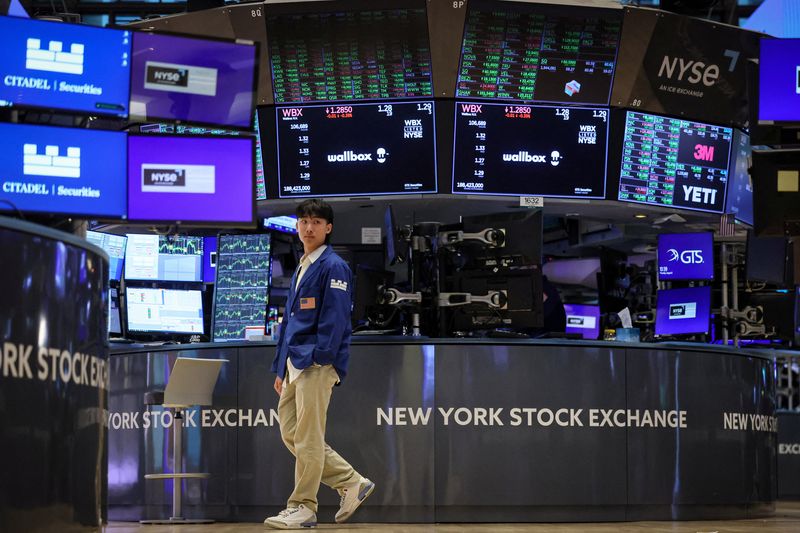By Sinéad Carew and Harry Robertson
NEW YORK/LONDON (Reuters) -A closely followed global equities index jumped more than 1% on Thursday after lower-than-expected weekly U.S. unemployment claims calmed recession fears, also pushing Treasury yields higher alongside the U.S. dollar.
Oil futures registered their third straight day of gains, with growing supply risks in the Middle East offsetting any demand concerns that at the start of the week had pushed prices to their lowest levels since early 2024.
The U.S. Labor Department said on Thursday that initial claims for state unemployment benefits fell 17,000 to a seasonally adjusted 233,000 for the week ended Aug. 3, marking the largest drop in about 11 months and falling short of economist expectations for 240,000.
The claims data was closely monitored after a weaker-than-expected July jobs report last Friday helped spark Monday's financial market rout that spanned the globe.
The sell-off was partly caused by investors being forced to unwind carry trades, where they borrow cheaply in Japan to buy dollars and other currencies to invest in higher yielding assets. The unwind helped trigger a 12% plunge in Japanese stocks on Monday and the S&P 500 followed with a 3% drop.
On Thursday, however, Wall Street's swing was bullish. The Dow Jones Industrial Average rose 683.04 points, or 1.76%, to 39,446.49, the S&P 500 gained 119.81 points, or 2.30%, to 5,319.31 and the Nasdaq Composite gained 464.22 points, or 2.87%, to 16,660.02.
Thursday's move was "a very, amplified reaction," to the claims data said Tony Roth, chief investment officer Wilmington Trust in Radnor, Pennsylvania.
"It's a lot more importance being ascribed to a single minor data point than you'd typically see. Jobless claims is important but any one reading is minor in a very high-frequency data set. There's a lot of volatility around it."
But he said that the latest data was particularly encouraging after the weak July jobs report and a better than expected services sector survey earlier this week.
"Today is the second data point we got this week which suggests that the July report last Friday was the aberration," he said.
But strategists and money managers suggest that investors should prepare for more volatility with other factors in play besides the typical weakness seen in August and September.
"We've U.S. elections, heightened geopolitical tensions in the Middle East and poor seasonality as well as the incoming economic data and the Fed's reaction to it. We're in a period of heightened uncertainty and the market hates uncertainty," said Irene Tunkel, chief U.S. equity strategist at BCA Research.
Earlier, Europe's STOXX 600 index closed up 0.08%.
MSCI's gauge of stocks across the globe rose 11.40 points, or 1.48%, to 782.10. Prior to Thursday's session, the global index had registered 16 daily losses or gains of 1% or more while the S&P 500 has registered 32 such moves so far this year.
STRONGER DOLLAR
In the currency market, the dollar index, which measures the greenback against a basket of currencies including the yen and the euro, gained 0.09% at 103.20, with the euro down 0.04% to $1.0917.
Against the Japanese yen, the dollar strengthened 0.3% to 147.13.
Earlier on Thursday, yields on U.S. Treasuries rose after the unemployment claims data fuelled hopes that the U.S. economy would not face an imminent recession. Then muted demand for a 30-year bond auction added to the rise in yields, coming a day after a weak sale of 10-year notes.
The yield on benchmark U.S. 10-year notes rose 2.1 basis points to 3.988%, from 3.967% late on Wednesday.
The 30-year bond yield rose 1.6 basis points to 4.2775% from 4.261%.
The 2-year note yield, which typically moves in step with interest rate expectations, rose 2.9 basis points to 4.0297%, from 4.001% late on Wednesday.

In energy markets, U.S. crude settled up 1.28%, or 96 cents at $76.19 a barrel and Brent finished at $79.16 per barrel, up 1.06% on the day.
In precious metals, spot gold added 1.78% to $2,423.87 an ounce. U.S. gold futures gained 1.25% to $2,420.50 an ounce.
